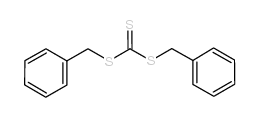bis(benzylsulfanyl)methanethione
Modify Date: 2024-01-06 17:33:07

bis(benzylsulfanyl)methanethione structure
|
Common Name | bis(benzylsulfanyl)methanethione | ||
|---|---|---|---|---|
| CAS Number | 26504-29-0 | Molecular Weight | 290.46700 | |
| Density | 1.249g/cm3 | Boiling Point | 469ºC at 760 mmHg | |
| Molecular Formula | C15H14S3 | Melting Point | 29-33 °C | |
| MSDS | Chinese USA | Flash Point | 237.5ºC | |
| Symbol |

GHS07 |
Signal Word | Warning | |
| Name | bis(benzylsulfanyl)methanethione |
|---|---|
| Synonym | More Synonyms |
| Density | 1.249g/cm3 |
|---|---|
| Boiling Point | 469ºC at 760 mmHg |
| Melting Point | 29-33 °C |
| Molecular Formula | C15H14S3 |
| Molecular Weight | 290.46700 |
| Flash Point | 237.5ºC |
| Exact Mass | 290.02600 |
| PSA | 82.69000 |
| LogP | 5.13810 |
| Vapour Pressure | 1.6E-08mmHg at 25°C |
| Index of Refraction | 1.683 |
| Storage condition | 2-8°C |
|
Section 1: Product Identification Chemical Name:S,S-Dibenzyltrithiocarbonate, min. 97% CAS Registry Number:26504-29-0 Formula:C15H14S3 EINECS Number:none Chemical Family:organosulfur compound Synonym:Bis(benzylsulfanyl)methanethione; Trithiocarbonic acid dibenzyl ester
Section 2: Composition and Information on Ingredients IngredientCAS NumberPercentACGIH (TWA)OSHA (PEL) Title compound26504-29-0100%no datano data Section 3: Hazards Identification Emergency Overview:Irritating to skin, eyes and respiratory tract. Primary Routes of Exposure:Ingestion, inhalation Eye Contact:Causes slight to mild irritation of the eyes. Skin Contact:Causes slight to mild irritation of the skin. Inhalation:Irritating to the nose, mucous membranes and respiratory tract. Ingestion:No information available on the physiological effects of ingestion. May be harmful if swallowed. Acute Health Affects:Irritating to skin, eyes and respiratory tract. Chronic Health Affects:No information on long-term chronic effects. NTP:No IARC:No OSHA:No SECTION 4: First Aid Measures Immediately flush the eyes with copious amounts of water for at least 10-15 minutes. A victim may need Eye Exposure: assistance in keeping their eye lids open. Get immediate medical attention. Wash the affected area with water. Remove contaminated clothes if necessary. Seek medical assistance if Skin Exposure: irritation persists. Remove the victim to fresh air. Closely monitor the victim for signs of respiratory problems, such as difficulty Inhalation: in breathing, coughing, wheezing, or pain. In such cases seek immediate medical assistance. Seek medical attention immediately. Keep the victim calm. Give the victim water (only if conscious). Induce Ingestion: vomiting only if directed by medical personnel. SECTION 5: Fire Fighting Measures Flash Point:no data Autoignition Temperature:no data Explosion Limits:no data Extinguishing Medium:carbon dioxide, dry powder or foam If this product is involved in a fire, fire fighters should be equipped with a NIOSH approved positive pressure Special Fire Fighting Procedures: self-contained breathing apparatus and full protective clothing. Hazardous Combustion andIf involved in a fire this material may emit irritating fumes. Decomposion Products: Unusual Fire or Explosion Hazards: No unususal fire or explosion hazards. SECTION 6: Accidental Release Measures Spill and Leak Procedures:Small spills can be mixed with vermiculite or sodium carbonate and swept up. SECTION 7: Handling and Storage Store in a tightly sealed container under an inert atmosphere of nitrogen or argon. Store cold. Prolonged Handling and Storage: exposure to air and moisture will degrade the material. SECTION 8: Exposure Controls and Personal Protection Eye Protection:Always wear approved safety glasses when handling a chemical substance in the laboratory. Skin Protection:Wear protective clothing and gloves. Ventilation:Handle the material in an efficient fume hood. If ventilation is not available a respirator should be worn. The use of respirators requires a Respirator Respirator: Protection Program to be in compliance with 29 CFR 1910.134. Ventilation:Handle the material in an efficient fume hood. Additional Protection:No additional protection required. SECTION 9: Physical and Chemical Properties Color and Form:dark yellow liquid Molecular Weight:290.47 Melting Point:no data Boiling Point:172°C /0.06 mm Vapor Pressure:no data Specific Gravity:no data Odor:slight rotten egg smell Solubility in Water:insoluble SECTION 10: Stability and Reactivity Stability:moisture sensitive (store cold) Hazardous Polymerization:no hazardous polymerization Conditions to Avoid:none Incompatibility:oxidizing agents and halogens Decomposition Products:carbon monoxide, carbon dioxide, sulfur oxides and organic fumes SECTION 11: Toxicological Information RTECS Data:No information available in the RTECS files. Carcinogenic Effects:no data Mutagenic Effects:no data Tetratogenic Effects:no data SECTION 12: Ecological Information Ecological Information:No information available SECTION 13: Disposal Considerations Disposal:Dispose of according to local, state and federal regulations. SECTION 14: Transportation Shipping Name (CFR):Non-hazardous Hazard Class (CFR):NA Additional Hazard Class (CFR):NA Packaging Group (CFR):NA UN ID Number (CFR):NA Shipping Name (IATA):Non-hazardous Hazard Class (IATA):NA Additional Hazard Class (IATA):NA Packaging Group (IATA):NA UN ID Number (IATA):NA SECTION 15: Regulatory Information TSCA:Not listed in the TSCA inventory SARA (Title 313):Title compound not listed Second Ingredient:none SECTION 16 - ADDITIONAL INFORMATION N/A |
| Symbol |

GHS07 |
|---|---|
| Signal Word | Warning |
| Hazard Statements | H315-H317-H319 |
| Precautionary Statements | P280-P305 + P351 + P338 |
| Hazard Codes | Xi |
| Risk Phrases | 36/38-43 |
| Safety Phrases | 26-36/37 |
| RIDADR | NONH for all modes of transport |
| HS Code | 2930909090 |
| HS Code | 2930909090 |
|---|---|
| Summary | 2930909090. other organo-sulphur compounds. VAT:17.0%. Tax rebate rate:13.0%. . MFN tariff:6.5%. General tariff:30.0% |
|
Thiocarbonylthio compounds (SC (Z) SR) in free radical polymerization with reversible addition-fragmentation chain transfer (RAFT polymerization). Chiefari, J., Mayadunne, R. T., Moad, C. L., Moad, G., Rizzardo, E., Postma, A., & Thang, S. H.
Macromolecules 36(7) , 2273-2283, (2003)
|
|
|
One-step synthesis of block copolymers using a hydroxyl-functionalized trithiocarbonate RAFT agent as a dual initiator for RAFT polymerization and ROP Kang, H. U., Yu, Y. C., Shin, S. J., & Youk, J. H.
J. Polym. Sci. A Polym. Chem. 51(4) , 774-779, (2013)
|
|
|
Synthesis of stimuli-sensitive copolymers by RAFT polymerization: potential candidates as drug delivery systems Tebaldi, M. L., Leal, D. A., Montoro, S. R., & Petzhold, C.
J. Mater. Res. , (2014)
|
| trithiocarbonic acid dibenzyl ester |
| dibenzyl trithiocarbonate |
| S,S-Dibenzyl trithiocarbonate |
| dibenzyl carbonotrithioate |
| S,S-DIBENZYLTRITHIOCARBONATE |